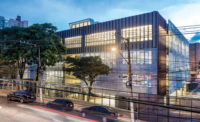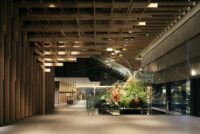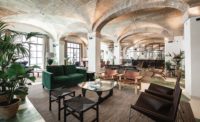Thanks to a development and construction boom that began in 2011, downtown Detroit is now full of sleek, renovated office buildings. The Detroit Foundation Hotel, however, is a preservation project like no other. To say the 95,000-square-foot hotel, largely located in a 1929 building that once housed the city’s fire department headquarters, is “hot” would be an understatement. Since opening last May, it has become a global destination—as evidenced by the number of foreign guests during a recent visit.
Additional Content:
Jump to credits & specifications
Designed by local firm McIntosh Poris Associates (MPA), the modern 100-room hotel—with everything from fitness facilities to a podcast studio—emerged from the aging municipal building once filled with clerks’ offices and sleeping quarters for firefighters. Many of the neoclassical structure’s existing details were intact, though the seven hefty red doors that fire trucks once raced from were removed, repaired, and stripped of layers of paint in order to discover the original color. Terra-cotta relief panels sporting firefighting themes—gryphon-like heads, hydrants, and winged serpents—frame the arched portals. Inside, the Apparatus Room, a vast 1½-story restaurant and bar situated off the ground-floor lobby, still has the original floor-to-ceiling columns and glazed-tile walls, reflecting its previous function as the firehouse equipment room. Historic photos and newspaper articles framed on the walls and set into glass coffee tables help guests to time-travel.
The architects worked on the preservationand renovation alongside the Aparium Hotel Group, local developer Walter Cohen, and the Simeone Deary Design Group based in Chicago. From the inception, the team’s goal was to create a place that would be “about the character and bones of the firehouse and about the city of Detroit,” explains MPA principal Michael Poris, who grew up in Detroit.
The hotel’s narrative dates back to 2012, when Poris learned that the fire department was moving to a new location and the building would soon be up for sale by the city. The architect contacted Cohen, with whom he had worked previously, and the two settled on proposing a hotel for the site. It was across the street from a conference center, and “we knew a hotel would create more jobs in the city than a retail or residential development,” says Poris.
Their bid was selected, and Detroit went bankrupt the following year, requiring Michigan’s governor to sign off on the project instead of the mayor. This bureaucratic hiccup caused a yearlong delay.
The landmarked building was in good shape, though years of dirt and soot would take time to clean. It was also too small to accommodate the number of hotel rooms needed to make the project work financially, so the partners bought the building next door, a four-story structure built in the 1880s. Once a popular French restaurant, it too had a historic designation.
With that purchase came another headache, Poris recalls. “We had to join the two buildings— the first made of steel with a red sandstone-and-masonry facade, the second load-bearing brick—and the floors of one building didn’t line up with the floors in the other.” In the end, they decided to connect the two with half-level staircases and one elevator that makes 14 stops between them.
Historic tax credits were available for both, so preserving and salvaging as much as possible was imperative. Poris brought in Architectural Salvage Warehouse of Detroit to reclaim, inventory, and repurpose interior wood trim from the building as well as from abandoned buildings throughout the city. Still, one of the firm’s most challenging hurdles was balancing both commercial and conservation demands. The National Trust took issue with two specific design elements. One was the addition of a modern banquet room on the rooftop of the second building, which would be seen from the street; the other was the destruction of a marble corridor in the 1920s building to make room for guest rooms on the fourth floor. Since the banquet hall was critical to the project’s financial success, the developers chose to forgo the tax credit on that building. Poris then preserved the original marble walls and floors in the disputed corridor of the firehouse.
Collaborating closely with MPA, interior designer Gina Deary hired local creatives like Matt Eaton, the director and curator of the Red Bull House of Art. Eaton introduced the Chicago-based Deary to Detroit artists and makers, resulting in installations such as two by Incite Design in the Apparatus Room: “Smoke Puff,” a large pendant made of metal-fabric panels hanging above a banquette, and a constellation of bulbs over the bar, many unlit, to represent the lack of working streetlights in Detroit’s most impoverished neighborhoods.
Upstairs, guests can choose from among 55 room layouts and decors, including the wood-paneled Commissioner’s Suite, which has a bathroom the size of most of the other guest rooms. The work of a different local artist is highlighted on each of the four guest floors.
Construction costs topped out at $20.5 million, just over the planned construction budget of $19 million. According to Poris, collaborating with the owners, builders, designers, and artists epitomized the spirit of working together in Detroit. “I knew if I did that, the result would be better. And that turned out to be true.”
CreditsArchitect: McIntosh Poris Associates — Michael Poris, principal; John Skok, associate/project manager; Kelly Raczkowski, Sean Ryan, Blake Hill, designers
Interior designer: Simeone Deary Design Group
Engineers: Structural Design, Inc. (structural); MA Engineering (m/e/p); Giffels Webster (civil and traffic)
Consultants: Illuminart (lighting design); Soundscape (acoustical design); Kraemer Design Group (historic preservation); Matt Eaton, Kim Harty, Lisa Spindler, Patrick Ethen (artists); Sorbis (low-voltage design)
General contractor: Sachse Construction |
SpecificationsWindows Quaker Windows & Doors (aluminum)
Doors BlackBerry Systems (restored firehouse); Curries (metal); VT Industries (wood)
Walls Benjamin Moore (paint); Detroit Wallpaper
Flooring Bolon (resilient); Durkan (carpet) |



















Post a comment to this article
Report Abusive Comment